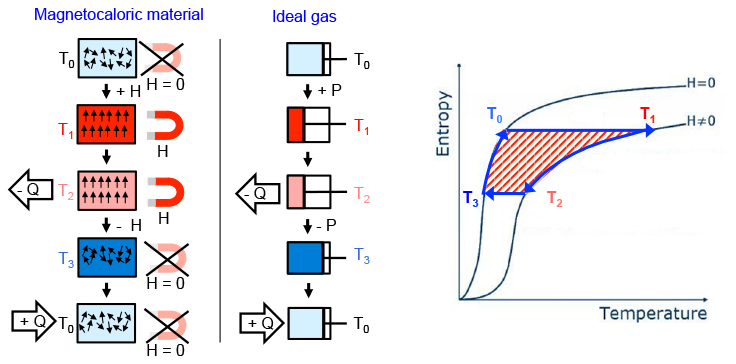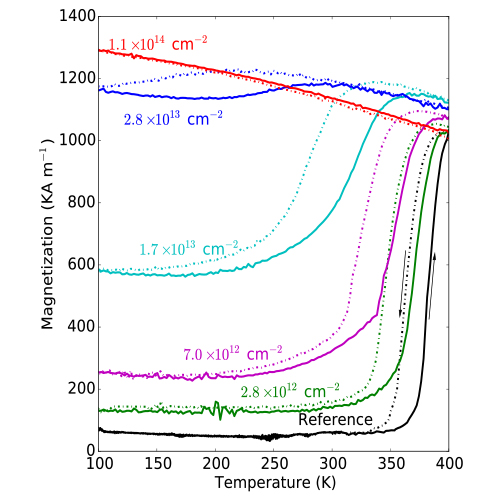Team
- Permanent members: Martino Trassinelli, Christophe Prigent, Emily Lamour, Anna Lévy, Sébastien Steydli, Stéphane Macé, Dominique Vernhet
The goal of this research topic is to study the interaction between heavy ions and thin films with giant magnetocaloric effect (GMCE) and long-term induced modifications on these samples. GMCE is related to a large variation in entropy associated to a first-order phase transition. Thanks to this large variation in entropy when an external magnetic field is applied, GMCE materials are very interesting for their use in magnetic refrigeration, a new alternative method, more efficient and more environmentally friendly than the commonly used refrigeration methods. However, applications are currently limited by two factors:
- the presence of hysteresis phenomena related to the first-order phase transition
- the difficulty of tuning in a controlled manner the temperature at which the magnetocaloric effect is maximal.

Figure 1: Left: Comparison between a magnetic refrigeration thermal cycle (Brayton cycle) and the gas compression / expansion cycle commonly used. Right: The same cycle represented on the entropy-temperature diagram.
.
In recent years, we discovered a method to solve these two obstacles based on heavy ion irradiation of these materials. We have been able to demonstrate that it is possible to reduce and even completely and permanently eliminate the hysteresis while preserving the giant magnetocaloric properties of thin films of manganese arsenide [1, 2].

Figure 2: Left: suppression of the thermal hysteresis by irradiation of ions in thin layers of MnAs (applied fields of 1 T). Right: Peak of the magnetic entropy corresponding to the application of a 2 T magnetic field on irradiated and reference samples.

Figure 3: Shift of the transition temperature by irradiation of ions in thin layers of FeRh at different fluences.
Collaborations
- INSP, Growth and properties of hybrid thin film systems team (M. Marangolo)
- SATIE (M. Lo Bue)
- CNRS / Thales laboratory (V. Garcia).
From October 2018, this research line will be developed within the ANR HyPerTherMag project.
Thesis
2014–2017, S. Cervera, Manipulation des propriétés magnétiques de matériaux à effet magnétocalorique géant par impact d’ions lourds
Patent
- Trassinelli, S. Cervera, D. Vernhet, M. Marangolo, and V. Garcia, Procédé d’obtention d’un matériau à effet magnétocalorique géant par irradiation d’ions. 4 April, 2017
Publications
- M.Trassinelli, M. Marangolo, M. Eddrief, Victor H. Etgens, V. Gafton, et al.. Suppression of the thermal hysteresis in magnetocaloric MnAs thin film by highly charged ion bombardment. Applied Physics Letters, American Institute of Physics, 2014, 104 (8), pp.081906. ⟨10.1063/1.4866663⟩. ⟨hal-00944462⟩
- M. Trassinelli, L Bernard Carlsson, S Cervera, M Eddrief, Victor H. Etgens, et al.. Low energy Ne ion beam induced-modifications of magnetic properties in MnAs thin films. Journal of Physics: Condensed Matter, IOP Publishing, 2016, 29 pp.055001 ⟨10.1088/1361-648X/29/5/055001⟩. ⟨hal-01390149⟩
- S. Cervera, M. Trassinelli, M. Marangolo, C. Carrétéro, V. Garcia, et al.. Modulating the phase transition temperature of giant magnetocaloric thin films by ion irradiation. Physical Review Materials, American Physical Society, 2017, 1, pp.065402. ⟨10.1103/PhysRevMaterials.1.065402⟩. ⟨hal-01618401⟩

